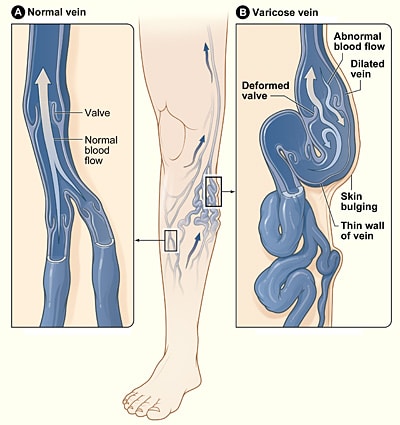This article is for educational purposes only. It should not be used as a template for consenting patients. The person obtaining consent should have clear knowledge of the procedure and the potential risks and complications. Always refer to your local or national guidelines, and the applicable and appropriate law in your jurisdiction governing patient consent.
Overview of Procedure

Figure 1 – Varicose veins are dilation of the superficial venous system
High tie and stripping is performed to treat venous reflux at either the long (LSV) or short saphenous vein (SSV).
The procedure tends to only be undertaken if the patient is unsuitable for endovenous ablation, which may be due to the size of the vein (too large), tortuosity (making cannulation and wire manipulation difficult) or superficial nature of the vein.
It is performed through a 2-3 cm groin crease incision at the LSV, the vein is tied off at the junction of the deep vein, and stripped down the leg. Direct stab punctures to remove additional tortuous varicosities in the lower leg are then undertaken.
Complications
Intra-Operative
| Complication | Description of Complication | Potential Ways to Reduce Risk |
| Haemorrhage | This can occur due to damage to either the femoral artery or the femoral vein or its branches, and may require blood transfusion, although this is extremely rare in varicose vein surgery. | |
| Injury to surrounding structures | The femoral artery and femoral vein are adjacent to the LSV and can become damaged. The sural nerve is close to the SSV and can become damaged during dissection. | |
| Anaesthetic risks | Includes damage to the teeth, throat and larynx, reaction to medications, nausea and vomiting, cardiovascular and respiratory complications. | Forms a part of the anaesthetist assessment before the operation |
Early
| Complication | Description of Complication | Potential Ways to Reduce Risk |
| Pain | There will be minimal pain with this procedure, requiring simple analgesia only. | |
| Nerve Injury | In approximately 5% of patients, sensation in the top or outer border of the foot may be damaged due to local nerve damage. | |
| Bleeding | There is a small chance of bleeding and bruising in the groin post-surgery. | |
| Infection | Superficial wound infection is possible, and most common in the groin. | Peri-operative antibiotics will reduce the risk of wound and graft infections |
| Scarring | A transverse incision will result in a scar, which can develop to form a keloid scar | |
| Seroma | A swelling of lymphatic fluid may occur in the abdomen due to disruption of the lymph nodes and channels. | Careful dissection of the lymphatic nodes and channels with ligation will minimise this risk. |
| Blood Clots | DVTs and PEs are a possibility in any operation. The risk is increased in patients with a raised BMI, on the pill, recent flights, previous DVT, pregnancy, smokers, cancer and prolonged bed rest. | The patient will be given anti-embolism stocking and low molecular weight heparin peri-operatively to minimise this risk as deemed appropriate. |
Late
| Complication | Description of Complication | Potential Ways to Reduce Risk |
| Reintervention | Varicose veins are often recurrent, with treatment of one segment later leading to varicose changes in another branch of the venous tree. |
